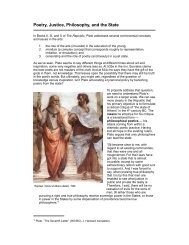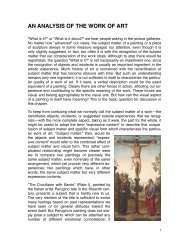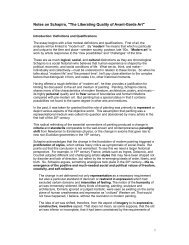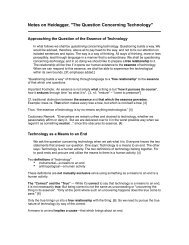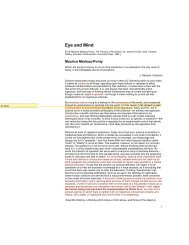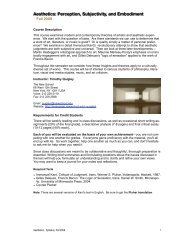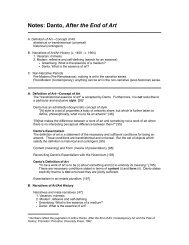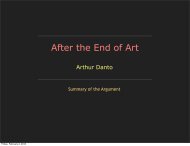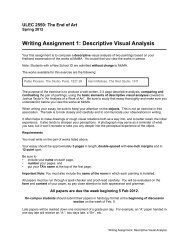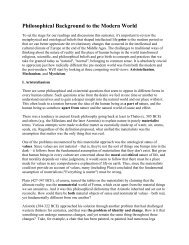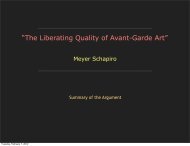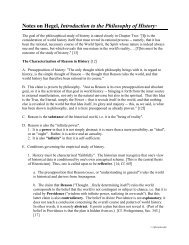Experience and Experiment in Art - Timothy R. Quigley
Experience and Experiment in Art - Timothy R. Quigley
Experience and Experiment in Art - Timothy R. Quigley
You also want an ePaper? Increase the reach of your titles
YUMPU automatically turns print PDFs into web optimized ePapers that Google loves.
Alva Noë<strong>Experience</strong> <strong>and</strong> <strong>Experiment</strong> <strong>in</strong> <strong>Art</strong>The danger that lies <strong>in</strong> describ<strong>in</strong>g th<strong>in</strong>gs as more simple than they really are is todayoften very overestimated. This danger does actually exist <strong>in</strong> the highest degree forthe phenomenological <strong>in</strong>vestigation of sense impressions. These are always taken tobe much simpler than they really are. — Ludwig Wittgenste<strong>in</strong> (1964, p. 281). 1To be an artist is not a matter of mak<strong>in</strong>g pa<strong>in</strong>t<strong>in</strong>gs or objects at all. What we are reallydeal<strong>in</strong>g with is our state of consciousness <strong>and</strong> the shape of our perception.— Robert Irw<strong>in</strong> (1972a). 2A significant impediment to the study of perceptual consciousness is our dependenceon simplistic ideas about what experience is like. This is a po<strong>in</strong>t that has beenmade by Wittgenste<strong>in</strong>, <strong>and</strong> by philosophers work<strong>in</strong>g <strong>in</strong> the PhenomenologicalTradition, such as Husserl <strong>and</strong> Merleau-Ponty. Importantly, it is an observationthat has been brought to the fore <strong>in</strong> recent discussions of consciousness amongphilosophers <strong>and</strong> cognitive scientists who have come to feel the need for a morerigorous phenomenology of experience. (See, for example, the papers collected <strong>in</strong>Varela & Shear, 1999; also Pessoa et al., 1998; Noë et al., 2000).The central thought of this paper is that art can make a needed contribution tothe study of perceptual consciousness. The work of some artists can teach usabout perceptual consciousness by furnish<strong>in</strong>g us with the opportunity to have aspecial k<strong>in</strong>d of reflective experience. In this way, art can be a tool forphenomenological <strong>in</strong>vestigation.The paper has three parts. First, I present what I call the problem of the transparencyof experience. This is a problem for philosophy, for art, <strong>and</strong> for cognitive[1] My translation of the German orig<strong>in</strong>al.[2] This passage is cited <strong>in</strong> the brochure accompany<strong>in</strong>g Irw<strong>in</strong>’s 1998 exhibition at the Dia Center for the<strong>Art</strong>s<strong>in</strong> New York entitled Part I: Prologue: x183, Part II: Excursus: Homage to the Square3, April 12,1998–June 13, 1999. Elsewhere Irw<strong>in</strong> writes: ‘The act of art has turned to a direct exam<strong>in</strong>ation of ourperceptual processes’ (Irw<strong>in</strong>, 1972b). This is also cited <strong>in</strong> the same brochure.Journal of Consciousness Studies, 7, No. 8–9, 2000, pp. 123–35
124 A. NOËscience. Second, I present an alternative conception of experience as a mode of<strong>in</strong>teractive engagement with the environment. F<strong>in</strong>ally, aga<strong>in</strong>st the background ofthis conception, I discuss, briefly, the work of the sculptors Richard Serra <strong>and</strong>Tony Smith. 3I: The Transparency of Perceptual <strong>Experience</strong>Part of what makes perceptual consciousness so difficult to grasp, whether <strong>in</strong> scienceor art, is its transparency. We can illustrate this by means of a fable. Onceupon a time there were artists who sought, <strong>in</strong> their art, to depict reality. For these‘realists’, art was a way of <strong>in</strong>vestigat<strong>in</strong>g the world. Then someone noticed thatknowledge of the world can be an obstacle to its successful depiction. What mattersis not how the world is, but how it presents itself to us <strong>in</strong> experience. ‘Free theeye from the dom<strong>in</strong>ion of the underst<strong>and</strong><strong>in</strong>g’ became the slogan of the new‘experientialist’ artists who thus came to overthrow realism. But before longexperientialism, <strong>in</strong> its turn, is thrown <strong>in</strong> to crisis. For to capture <strong>in</strong> a picture howthe world presents itself to us <strong>in</strong> experience — to make a picture of how th<strong>in</strong>gstruly appear — is just to make a picture of that which is experienced, of that whichappears, namely the world. The subject matter of art-mak<strong>in</strong>g, then, is not experienceitself, but the experienced world, <strong>and</strong> so art must direct itself to the world.Experientialism <strong>in</strong> this way collapses back <strong>in</strong>to realism <strong>and</strong> the struggle beg<strong>in</strong>s allover aga<strong>in</strong>. An oscillation ensues between realism <strong>and</strong> experientialism.This fable is meant to get at the follow<strong>in</strong>g idea. When we try to make perceptualexperience itself the object of our reflection, we tend to see through it (so tospeak) to the objects of experience. We encounter what is seen, not the qualities ofthe see<strong>in</strong>g itself. This idea was noticed by Grice, who wrote:If we were asked to pay close attention, on a given occasion, to our see<strong>in</strong>g or feel<strong>in</strong>gas dist<strong>in</strong>ct from what was be<strong>in</strong>g seen or felt, we should not know how to proceed; <strong>and</strong>the attempt to describe the differences between see<strong>in</strong>g <strong>and</strong> feel<strong>in</strong>g seems to dissolve<strong>in</strong>to a description of what we see <strong>and</strong> what we feel (1962, p. l44).This is a familiar theme <strong>in</strong> philosophy. An accurate description of visual experiencewill conf<strong>in</strong>e itself to those objects whose presence is guaranteed by theexperience itself, e.g. blobs of colour. Or so at least Hume (1740/1978), <strong>and</strong>philosophers work<strong>in</strong>g <strong>in</strong> his tradition, such as Price (1940) <strong>and</strong> Ayer (1973), haveargued. When we talk of what we see (e.g. deer graz<strong>in</strong>g on a lawn), we ‘gobeyond’ what is strictly given to us <strong>in</strong> experience.Kant (1787/1929) attacked this idea of Hume’s <strong>and</strong> <strong>in</strong>sisted that we falsifyexperience when we attempt to describe it <strong>in</strong> these supposedly neutral terms (asnoticed by Strawson, 1979). I am not more faithful to my experience of the deer,but less, when I try to describe it <strong>in</strong> terms of my experience of brownish blobs on agreen background. To be faithful to experience, I must talk about the way the[3] Images of works of Serra <strong>and</strong> Smith may be viewed at various sites on the <strong>in</strong>ternet.Interested readers may want to visit <strong>and</strong>.
EXPERIENCE AND EXPERIMENT IN ART 125Figure 1Mach (1886/1959). The visual field.experience purports to represent the world (Strawson, 1979). To describe experienceis to describe the experienced world. And so experience is, <strong>in</strong> this sense,transparent.
126 A. NOËThe transparency of experience, it should be clear, poses a problem for anyattempt to make perceptual experience itself the object of <strong>in</strong>vestigation <strong>in</strong> the waythat has <strong>in</strong>terested philosophers. But it is important to recognize that this problemof transparency arises no less for the empirical (psychological, neuroscientific)study of consciousness.Consider Ernst Mach’s famous draw<strong>in</strong>g (figure 1) of the visual field (Mach1886/1959). The draw<strong>in</strong>g is meant to serve as a representation not of the room,but of the visual experience itself, captur<strong>in</strong>g on paper the dist<strong>in</strong>ctive character ofvisual awareness (as the artist sits with fixed monocular gaze look<strong>in</strong>g out on hisroom). Notice that the draw<strong>in</strong>g <strong>in</strong>dicates the presence of the nose, moustache,belly, body at the periphery, that it represents the field as <strong>in</strong> sharp focus <strong>and</strong> uniformdetail from the center out to the periphery, where th<strong>in</strong>gs go <strong>in</strong>dist<strong>in</strong>ct.Mach’s draw<strong>in</strong>g fails (as noticed by Wittgenste<strong>in</strong>). 4 The picture does not capturewhat the visual field is like. It is true that the visual field is <strong>in</strong>dist<strong>in</strong>ct at theperiphery. But the character of this <strong>in</strong>dist<strong>in</strong>ctness is not captured by thefade-to-white. That is, it doesn’t seem to us as if the visual field fades to white atthe edges. Consider also that the visual field is not <strong>in</strong> this way uniformly detailed<strong>and</strong> <strong>in</strong> sharp focus from the centre out to the periphery. You only see sharply thatwhich you fixate, but you don’t fixate such an expanse all at once.Mach, it seems, misdescribes what it is like to see. At best, he succeeds <strong>in</strong>depict<strong>in</strong>g his room. We see the familiar oscillation at work. He tries to direct himselfto his experience, but , like the experientialists of the fable, he directs himself<strong>in</strong>stead to the world. <strong>Experience</strong>, when thought of along these l<strong>in</strong>es, is too transparentto capture <strong>in</strong> thought or on paper.II: <strong>Experience</strong> as a Temporally Extended Pattern of Exploratory ActivityThe puzzle of the transparency of experience results from th<strong>in</strong>k<strong>in</strong>g of experiencesas like <strong>in</strong>ner pictures <strong>and</strong> from th<strong>in</strong>k<strong>in</strong>g of reflection on experience as like turn<strong>in</strong>gone’s gaze <strong>in</strong>ward to those pictures. But this is a false characterization of experience.In experience we are aware not of <strong>in</strong>ner pictures, but of the th<strong>in</strong>gs around us<strong>in</strong> the environment.To defend this claim, consider Mach’s draw<strong>in</strong>g aga<strong>in</strong>. We noticed that thedraw<strong>in</strong>g represents the visual field as too sharp throughout, as too def<strong>in</strong>ed, <strong>and</strong>that the characteristic <strong>in</strong>dist<strong>in</strong>ctness of the visual field at the periphery is not capturedby the fade-to-white. We can summarize the picture’s misrepresentation ofexperience as follows: the picture gives expression to the idea that when you see,you have all the environmental detail <strong>in</strong> your consciousness at once. Let’s call thisthe ‘details <strong>in</strong> the head’ conception of perceptual (or visual) experience.[4] Wittgenste<strong>in</strong> remarked that Mach’s draw<strong>in</strong>gs is one of the clearest examples of confusion betweenphysical <strong>and</strong> phenomenological modes of description. Referr<strong>in</strong>g to the <strong>in</strong>adequacy of Mach’s representationof the blurredness of the visual field by means of a different k<strong>in</strong>d of blurredness <strong>in</strong> the draw<strong>in</strong>g,Wittgenste<strong>in</strong> remarked: ‘No, one cannot make a visible picture of the visual field’ (1964, p. 267;my translation). See Thompson et al. (1999) for more on this. A po<strong>in</strong>t very similar to Wittgenste<strong>in</strong>’sis made by Dennett (1991, p. 55), who writes: ‘One can no more pa<strong>in</strong>t a realistic picture of visualphenomenology than of justice or melody or happ<strong>in</strong>ess’.
EXPERIENCE AND EXPERIMENT IN ART 127It is worth notic<strong>in</strong>g that the ‘details <strong>in</strong> the head’ conception is, <strong>in</strong> fact, shared bymany visual <strong>and</strong> perceptual theorists. Indeed, visual scientists have long tended toth<strong>in</strong>k of their central task as that of try<strong>in</strong>g to determ<strong>in</strong>e how the bra<strong>in</strong> give rises torichly detailed picture-like experiences of this sort, on the basis of the paltry<strong>in</strong>formation about the environment projected onto the ret<strong>in</strong>a. 5Consider an example from touch that illustrates this established problematic. 6Suppose you hold a bottle <strong>in</strong> your h<strong>and</strong>s with your eyes shut. You feel it. You havethe feel<strong>in</strong>g of the presence of the whole bottle even though you only make f<strong>in</strong>ger-to-bottlecontact at a few po<strong>in</strong>ts. The st<strong>and</strong>ard account of this phenomenonproposes that the bra<strong>in</strong> takes the little <strong>in</strong>formation it receives (at the isolatedpo<strong>in</strong>ts of contact) <strong>and</strong> uses it to build up an <strong>in</strong>ternal model of the bottle (one capableof support<strong>in</strong>g the experience).But consider: this posit<strong>in</strong>g of a process of construction of an <strong>in</strong>ternal representationmay be an unnecessary shuffle. For the bottle is right there, <strong>in</strong> your h<strong>and</strong>s,to be probed as occasion arises. Why should the bra<strong>in</strong> build models of the environmentif the environment is present <strong>and</strong> so can serve as its own model, as an externalbut accessible repository for <strong>in</strong>formation (as has been argued by Brooks, 1991;O’Regan, 1992)?Recently a good deal of empirical support as been found for this ‘world as itsown model’ view (e.g. work on change bl<strong>in</strong>dness (reviewed by Simons, 2000),<strong>in</strong>attentional bl<strong>in</strong>dness (Mack & Rock, 1998), animate vision (Ballard, 1991),<strong>and</strong> embodied cognition (Brooks, 1991). But anecdotal evidence will suffice tomake us suspicious of the need for an <strong>in</strong>ternal model. Consider that we have allencountered the follow<strong>in</strong>g familiar stunt. You are d<strong>in</strong><strong>in</strong>g with a friend. You give astart <strong>and</strong> exclaim ‘Hey isn’t that so <strong>and</strong> so?’ Your friend turns around. While shelooks away you take a french fry. When she turns back, you shake your head <strong>and</strong>say that you must have been mistaken. She didn’t see you take the fry. She doesn’tnotice that a fry is miss<strong>in</strong>g. Why does she fail to notice that the fry is miss<strong>in</strong>g? Anumber of c<strong>and</strong>idate explanations suggest themselves. One such c<strong>and</strong>idate is asfollows: <strong>in</strong> exam<strong>in</strong><strong>in</strong>g her food she never built up a detailed <strong>in</strong>ternal modelaga<strong>in</strong>st which to compare her impression of the now altered pile of fries.But there is a deeper problem with the ‘details <strong>in</strong> the head’ conception of experience.It is phenomenologically wrong-headed. (For more on this, see Noë et al.,2000).Consider the bottle aga<strong>in</strong>. It is quite true that you have a sense of the whole bottleas present <strong>in</strong> your grasp. But surely it does not seem to you as if, all at once,[5] Recently this consensus has begun to come undone. A group of new th<strong>in</strong>kers have come to endorsewhat I have called the new scepticism about visual experience (Noë, <strong>in</strong> press). Traditional scepticismabout experience questions whether we can know, on the basis of experience, that th<strong>in</strong>gs are as weexperience them as be<strong>in</strong>g. The new scepticism, <strong>in</strong> contrast, questions whether we even have the experiencewe th<strong>in</strong>k we have. Whereas traditional visual science wondered how we can have such rich visualimpressions on the basis of such impoverished ret<strong>in</strong>al <strong>in</strong>put, the new visual science that takes its startfrom the new scepticism targets a rather different question: why does it seem to us as if we see so muchwhen, <strong>in</strong> fact, we see so little! The lead<strong>in</strong>g spokesperson for the new scepticism is Daniel Dennett. SeeNoë (<strong>in</strong> press) for extended discussion of this po<strong>in</strong>t.[6] This often used example is due to Donald MacKay (1962; 1967; 1973).
128 A. NOËwhen you hold the bottle, you <strong>in</strong> fact make contact with each <strong>and</strong> every part of itssurface! No. It seems to you, rather, as if the bottle is there <strong>in</strong> your h<strong>and</strong>s <strong>and</strong> as ifyou have access to it by movements. You are, <strong>in</strong> fact, as a perceiver, master of thesensorimotor skills required to exploit such access. The basis, then, of the feel<strong>in</strong>gof perceptual presence of the bottle is just this skill-based confidence that you canacquire the <strong>in</strong>formation at will by prob<strong>in</strong>g the world (O’Regan, 1992; O’Regan<strong>and</strong> Noë, under review).And so for vision. When you see, you take yourself to be aware of a denselydetailed world, to be sure. But you do not take yourself to have all that detail <strong>in</strong>consciousness all at once. The ‘details <strong>in</strong> the head’ model falsifies experience.Rather, you take yourself to have access to the detail by the flick of the eye or theturn of the head. The see<strong>in</strong>g, the experienc<strong>in</strong>g of all that detail, is not someth<strong>in</strong>gstatic, but someth<strong>in</strong>g temporally extended <strong>and</strong> active.The upshot of this discussion is that perceptual experience, <strong>in</strong> whatever sensorymodality, is a temporally extended process of exploration of the environmenton the part of an embodied animal. This is the key that unlocks the puzzle of transparency<strong>and</strong> so the problem of phenomenology. If perceptual experience is <strong>in</strong> facta temporally extended process, then to <strong>in</strong>vestigate experience we need to turn ourgaze not <strong>in</strong>ward, but rather to the activity itself <strong>in</strong> which this temporally extendedprocess consists, to the th<strong>in</strong>gs we do as we explore the world.III: Toward an <strong>Art</strong> of <strong>Experience</strong>I have proposed that to <strong>in</strong>vestigate visual experience — that is, to do visual phenomenology— we must <strong>in</strong>vestigate the temporally extended pattern of exploratoryactivity <strong>in</strong> which see<strong>in</strong>g consists. I now propose that to study some works ofart is to undertake precisely this sort of <strong>in</strong>vestigation. The study of such works ofart can serve as a model of how to study experience <strong>and</strong> can also reveal how artcan be, <strong>in</strong> the sense of Irw<strong>in</strong>’s quote given at the outset, not only concerned withthe mak<strong>in</strong>g of objects, but more significantly with the <strong>in</strong>vestigation of perceptualconsciousness.I will focus on Richard Serra, whose work perfectly exemplifies the ideas Ihave <strong>in</strong> m<strong>in</strong>d. However, there are <strong>and</strong> have been numerous other artists whoseprojects are experiential <strong>in</strong> the sense I have <strong>in</strong> m<strong>in</strong>d (e.g. Smithson, Irw<strong>in</strong>, Turell,to name only three). 7 What I shall argue is that Serra’s work (<strong>and</strong> also the work ofthese other artists) enables us to catch ourselves <strong>in</strong> the act of perceiv<strong>in</strong>g <strong>and</strong> canallow us thus to catch hold of the fact that experience is not a passive <strong>in</strong>teriorstate, but a mode of active engagement with the world. In this way, Serra br<strong>in</strong>gs torest the troubl<strong>in</strong>g oscillation between experientialism <strong>and</strong> realism. 8[7] My use of the term ‘experiential art’ is similar to the use made by R<strong>in</strong>der <strong>and</strong> Lakoff (1999) of the term‘consciousness art’.[8] Some readers might be struck by the fact that I now turn to sculpture after develop<strong>in</strong>g theto-be-criticized conception of experience with reference to a draw<strong>in</strong>g of Mach’s. Mach’s draw<strong>in</strong>g, Ith<strong>in</strong>k, illustrates the problematic conception of experience that is my real object. It is not my <strong>in</strong>tent,however, to suggest that there is an <strong>in</strong>tr<strong>in</strong>sic connection between draw<strong>in</strong>g as a medium <strong>and</strong> the problematicconception. For reasons that will, I hope, become clear, some sculpture provides an apt method
EXPERIENCE AND EXPERIMENT IN ART 129Figure 2Richard Serra Sp<strong>in</strong> Out: For Bob Smithson 1972–1973. Illustration by Miriam Dym.Before turn<strong>in</strong>g to the work itself, let me be very clear about what I am do<strong>in</strong>g<strong>and</strong> about what I am not do<strong>in</strong>g. I am not argu<strong>in</strong>g that the conception of experienceI advocate fixes or solves any aesthetic problems. I argue, rather, that — aga<strong>in</strong>stthe background of this conception of experience — we can appreciate howSerra’s work (<strong>and</strong> the work of others) helps clarify certa<strong>in</strong> theoretical problemsabout consciousness. Now it might <strong>in</strong> fact be the case that the analysis hereoffered does <strong>in</strong> fact help to solve certa<strong>in</strong> puzzles of an aesthetic nature aboutSerra’s <strong>and</strong> Smith’s work. If so, this rema<strong>in</strong>s secondary to the ma<strong>in</strong> purpose.A f<strong>in</strong>al prelim<strong>in</strong>ary: I do not claim that the <strong>in</strong>terpretation of Serra <strong>and</strong> Smithhere offered is particularly orig<strong>in</strong>al. S<strong>in</strong>ce develop<strong>in</strong>g these ideas I have learnedthat others — Rosalyn Kraus, Yve-Ala<strong>in</strong> Bois, Hal Foster — have anticipated mefor <strong>in</strong>vestigat<strong>in</strong>g experience thought of as a form of activity. But it is no part of my purpose to suggestthat picture-mak<strong>in</strong>g cannot also perform this role. Cézanne is an excellent example of a pa<strong>in</strong>ter who is,<strong>in</strong> my sense, an experiential artist. Merleau-Ponty (1948/1964) has made much the same po<strong>in</strong>t when heobserved that Cézanne’s is an art directed to the phenomenal which nevertheless avoids the‘ready-made alternatives’ that preoccupied impressionism (e.g. ‘sensation versus judgment’, ‘thepa<strong>in</strong>ter who sees aga<strong>in</strong>st the pa<strong>in</strong>ter who th<strong>in</strong>ks’). Merleau-Ponty emphasizes that although Cézannerema<strong>in</strong>s faithful to the phenomenal, there is a clear sense <strong>in</strong> which he ‘returns to the object’. He does so<strong>in</strong> a way, however, that allows him to discover a ‘lived perspective’ that is at once experiential <strong>and</strong> alsodirected to the world. Cézanne’s pictures represent the environment as experienced. In this way, he isable to discharge the tension between experientialism <strong>and</strong> realism.
130 A. NOËFigure 3Richard Serra Runn<strong>in</strong>g Arcs (For John Cage) 1992. Each plate is 13' 1 1 / 2 " x 55' 9 3 / 8 " x 2".Illustration by Miriam Dym.<strong>in</strong> this or that respect. I am not, however, aware of anyone who has coord<strong>in</strong>atedthese various po<strong>in</strong>ts <strong>in</strong> relation to philosophy <strong>and</strong> cognitive science <strong>in</strong> just theway I have attempted to do.I turn now to the large-scale sculptures <strong>in</strong> metal that have been central toSerra’s work s<strong>in</strong>ce the 1970s. A strik<strong>in</strong>g example is Sp<strong>in</strong> Out: For Bob Smithson,which consists of three large plates of steel (each ten feet by forty feet by one <strong>and</strong>
EXPERIENCE AND EXPERIMENT IN ART 131a half <strong>in</strong>ches), each embedded <strong>in</strong>to the earth along the side of a hill <strong>in</strong> a roughlycircular array, as illustrated <strong>in</strong> figure 2. 9Let us note four characteristic features of Serra’s sculptures. First, many ofthem are, as I will put it, environmental. That is, they are <strong>in</strong>tr<strong>in</strong>sically sitespecific.What I mean by this is that the sculptures are not merely enhanced bytheir locations, but are made for their locations <strong>and</strong> are meant to become part ofthe environment. Some pieces (such as, for example, works <strong>in</strong> the recent TorquedEllipse series) lack site-specificity, <strong>in</strong> so far as they can be moved from one site toanother. But it would be a mistake to conclude from this that these works are notenvironmental. Crucially, these pieces are able to transform a location <strong>and</strong> so producea new environment.Second, like Borges’ map of the world which is built on the same scale as theworld itself, most of Serra’s sculptures are lack<strong>in</strong>g <strong>in</strong> perspicuity, that is, you cannottake one <strong>in</strong> at a glance. This has to do not only with their scale, but also withtheir complexity; to be understood they need to be explored. 10Third, a typical Serra sculpture, thanks to its scale, its surpris<strong>in</strong>g curves <strong>and</strong>apparent tilt, is overwhelm<strong>in</strong>g <strong>and</strong> disorient<strong>in</strong>g, sometimes even frighten<strong>in</strong>g,almost always <strong>in</strong>timidat<strong>in</strong>g. It dem<strong>and</strong>s a reaction. Fourth, <strong>and</strong> as a consequenceof the first three po<strong>in</strong>ts, the pieces are, as I shall put it, particulars. By this I meanthat they are unique, concrete entities. To encounter a Serra sculpture is to get toknow an <strong>in</strong>dividual. The significance of this po<strong>in</strong>t will emerge <strong>in</strong> a moment.With these features <strong>in</strong> m<strong>in</strong>d — environmental character or site-specificity, lackof perspicuity, overwhelm<strong>in</strong>g scale, <strong>and</strong> particularity — we can start to lay out themethod of phenomenological <strong>in</strong>vestigation deployed by the artist <strong>in</strong> these works.When one first encounters a piece, such as Runn<strong>in</strong>g Arcs (For John Cage)(figure 3), one is liable to be struck by the scale <strong>and</strong> the visually <strong>in</strong>scrutable orientations<strong>and</strong> distributions of weight. One not only notices these qualities, but one isdisturbed by them. One puzzles: what stops these giants from fall<strong>in</strong>g over? Tow<strong>and</strong>er around or through a piece such as this can cause a loss of balance. In thisway the works make us reflect on how we feel, perceptually, <strong>in</strong> their presence.And they direct our attention to the complexity of our experience, a complexitywe easily overlook. The loss of balance, for example, <strong>in</strong>troduces us to what arestrictly non-visual (e.g. vestibular, k<strong>in</strong>esthetic) components of our ‘visual’experience.If we press on <strong>and</strong> explore a piece by walk<strong>in</strong>g <strong>in</strong>to or around it, we come to feelat ease <strong>in</strong> or near it. In this way, we ga<strong>in</strong> a k<strong>in</strong>d of practical knowledge. We ga<strong>in</strong>knowledge about the spaces they occupy as places, or niches or environments.[9] In an <strong>in</strong>terview, Serra described the piece as follows: ‘The plates were laid out at twelve, four <strong>and</strong> eighto’clock <strong>in</strong> an elliptical valley, <strong>and</strong> the space <strong>in</strong> between forms an isosceles triangle, 152 feet on the longside, seventy-eight <strong>and</strong> seventy-eight feet on the legs. Each plate is ten feet high by forty feet long by1 1 / 2 <strong>in</strong>ches thick hot-rolled steel sunk <strong>in</strong>to the <strong>in</strong>cl<strong>in</strong>e at an equal elevation’ (1973, p. 16).[10] The aim of philosophy, Wittgenste<strong>in</strong> held, is the atta<strong>in</strong>ment of a ‘perspicuous overview’(übersichtliche Darstellung) of a region of grammar or conceptual space. To ga<strong>in</strong> such a perspicuousrepresentation is to ga<strong>in</strong> underst<strong>and</strong><strong>in</strong>g <strong>and</strong> to see th<strong>in</strong>gs aright. My use of the term ‘perspicuity’ ismeant to <strong>in</strong>voke this idea. Serra’s sculptures provide us opportunities to underst<strong>and</strong> the environmentwe live <strong>in</strong> by explor<strong>in</strong>g bits of it <strong>in</strong> order to atta<strong>in</strong> a perspicuous overview where at first there is none.
132 A. NOËFigure 4Tony Smith Cigarette 1961. Illustration by Miriam Dym.The process of explor<strong>in</strong>g the piece is a process of explor<strong>in</strong>g the place. It is likewisea process by which we come to underst<strong>and</strong> how experience can be, <strong>in</strong> thisway, a form of openness to the environment. In light of the forego<strong>in</strong>g discussionof perceptual experience as a mode of active exploration of the world, it should beclear that the process of explor<strong>in</strong>g the art work (<strong>and</strong> thus the environment <strong>in</strong>which it is situated), is at once a process of explor<strong>in</strong>g one’s experience of theworld. And the knowledge one thus atta<strong>in</strong>s is knowledge of the character of one’sexperience. 11In this way, Serra’s work br<strong>in</strong>gs the oscillation between experientialism <strong>and</strong>realism to a halt. Perceptual experience is transparent to the world precisely[11] The dynamic character of the appreciation of the work of art is underscored by Serra <strong>in</strong> his discussionsof the pieces. Consider further his remarks about Sp<strong>in</strong> Out: ‘First you see the plates as parallel; whenyou walk left, they move right. As you walk <strong>in</strong>to them, they open up, <strong>and</strong> there’s a certa<strong>in</strong> k<strong>in</strong>d of centrifugalpush <strong>in</strong>to the side of the hill. In fact the people at the Kröller-Müller wanted to call the piece“Centrifugaal” <strong>in</strong> Dutch. They talked a lot about vorticism. And then when you walk above it, there’sanother path which connects the two sides of the valley. . . . There’s a ridge which encircles the wholespace at about 150 feet. When you walk on the ridge, there’s a contraction <strong>and</strong> the space becomes ellipticallycompartmentalized, which you can’t see as you walk through it, <strong>and</strong> it’s a different way ofunderst<strong>and</strong><strong>in</strong>g your relation to the place: you’re overhead look<strong>in</strong>g down’ (1973, p. 16).
EXPERIENCE AND EXPERIMENT IN ART 133because experience is an activity of engagement with the world. To attend to theexploration of the world is thus to attend to the quality of experience. We canth<strong>in</strong>k of Serra’s work, <strong>and</strong> that of other experientialist artists, as provid<strong>in</strong>g opportunitiesfor first-person phenomenological <strong>in</strong>vestigation.Now there is of course a sense <strong>in</strong> which one could say of any object (<strong>and</strong> certa<strong>in</strong>lyany work of art) that it provides its viewer with an opportunity to reflect onwhat it is like to perceive it. What I am call<strong>in</strong>g experientialist art is art that f<strong>in</strong>dsits home <strong>in</strong> this self-reflective moment. While just about anyth<strong>in</strong>g can be madethe occasion of such a self-reflective act, it is important to notice that not all formsof art <strong>and</strong> not all artists undertake their activity <strong>in</strong> this vic<strong>in</strong>ity. We can deepen ourgrip on what dist<strong>in</strong>guishes Serra’s project as experientialist, by contrast<strong>in</strong>g hisworks with those of a superficially similar, <strong>and</strong> no less important artist, the sculptorTony Smith (see Figure 4).There are similarities of scale <strong>and</strong> material <strong>in</strong> the work of Smith <strong>and</strong> Serra —each makes metal sculptures suitable for outdoor <strong>in</strong>stallation at least twice theheight of a normal person. Smith’s work, however, <strong>in</strong> contrast with Serra’s, isutterly non-psychological. Where Serra’s works are experimential, Smith’s worksare geometrical or mathematical. Smith’s sculptures may be compared with whatmathematicians call constructive existence proofs. A constructive existenceproof demonstrates the existence of a mathematical entity by actually produc<strong>in</strong>g arelevant <strong>in</strong>stance.Smith’s constructions realize certa<strong>in</strong> ways of comb<strong>in</strong><strong>in</strong>g shapes(e.g. tetrahedrons) <strong>in</strong> order to fill out space <strong>and</strong> so demonstrate that it is possiblethus to fill out space. The space we learn about when we underst<strong>and</strong> a Smithsculpture is not the space we experience. Rather, it is the objective, abstract spaceof mathematics.It is this mathematical character of Smith’s work that expla<strong>in</strong>s another importantfeature that places it <strong>in</strong> direct opposition to that of Serra. Serra’s pieces are, asI’ve emphasized, particulars whose effectiveness depends on their environmentalcharacter, their scale <strong>and</strong> their complexity. They confront a person the way a steep<strong>in</strong>cl<strong>in</strong>e on the way home from work confronts a person. In contrast, Smith’spieces are representative or universal. A crucial fact about a geometrical constructionis that it <strong>in</strong>stantiates <strong>in</strong> the particular what are <strong>in</strong> fact wholly universalrelations. The particular triangle on which the geometer builds his or her constructionst<strong>and</strong>s for all triangles of the relevant k<strong>in</strong>d (equilateral, say). Its particularitydoes not matter. It is irrelevant to the significance of the demonstrationwhether it is written <strong>in</strong> chalk on the board or on pencil <strong>and</strong> paper, or whether it isdrawn to one scale or another. (This is a Kantian po<strong>in</strong>t. See Kant, 1787/1929, pp.576–93.) In precisely this sense, Smith’s sculptures have a k<strong>in</strong>d of immateriality.That is, their material is immaterial. They are multiply- realizable, lend<strong>in</strong>g themselvesto reproduction on different scales <strong>and</strong> out of different materials. 12 Theylack site-specificity. 13[12] The same cannot be said of Serra’s work. Small-scale maquettes of the Torqued Ellipses utterly lackthe aura of their full-scale counterparts.[13] It is <strong>in</strong>terest<strong>in</strong>g to note that if this read<strong>in</strong>g of Smith is right, then Fried (1967/1998) was mistaken toselect Smith as an example (<strong>in</strong>deed, as the example) of ‘theatrical art’. Smith’s works are self-st<strong>and</strong><strong>in</strong>g
134 A. NOËSerra once wrote that he is not <strong>in</strong>terested <strong>in</strong> sculpture ‘which is solely def<strong>in</strong>edby its <strong>in</strong>ternal relationships’ (Serra, 1973). Smith said <strong>in</strong> an <strong>in</strong>terview: ‘I don’tmake sculpture, I speculate <strong>in</strong> form’ (Gossen, 1981, cited <strong>in</strong> Storr, 1998). Thesecomments br<strong>in</strong>gs out the difference between their projects. Smith is concernedprecisely with the sculpture of <strong>in</strong>ternal relationships, with geometry, with form.Serra’s is a sculpture of consciousness.ConclusionMy aim <strong>in</strong> this paper has been to propose that we can th<strong>in</strong>k of the work of certa<strong>in</strong>artists (but not all) as provid<strong>in</strong>g methods for the study of experience. Serra’sworks, I have suggested, constitute experiments <strong>in</strong> a k<strong>in</strong>d of phenomenologicalpsychology. A Serra sculpture is an object for us to experience which functions todraw our attention to what we do when we experience it <strong>and</strong> to how th<strong>in</strong>gs arewith us perceptually. In do<strong>in</strong>g so, I have suggested, the work enables us to appreciatethat experience is a mode of direct contact with <strong>and</strong> exploration of the world.In this way, the works enable us to underst<strong>and</strong> both how experience can be transparent<strong>and</strong> why its transparency is no obstacle to scientific, philosophical <strong>and</strong>artistic <strong>in</strong>vestigation of experience. <strong>Experience</strong> is transparent to the worldbecause it is just a mode of active engagement with the world. Aphenomenological study of experience is not an exercise <strong>in</strong> <strong>in</strong>trospection, it is anact of attentiveness to what one does <strong>in</strong> explor<strong>in</strong>g the world. To reflect on thecharacter of experience, one must direct one’s attention to the temporallyextended, fully embodied, environmentally situated activity of exploration of theenvironment. Experiential art enables us to do this.AcknowledgementsThis paper is based on talks presented at the California College of <strong>Art</strong>s <strong>and</strong> Crafts<strong>in</strong> July 1998 <strong>and</strong> October 1999, at the Getty Research Center <strong>in</strong> May 1999, <strong>and</strong> atthe meet<strong>in</strong>gs of the College <strong>Art</strong> Association <strong>in</strong> New York <strong>in</strong> February 2000. I amgrateful to audiences at those meet<strong>in</strong>gs for helpful criticism, especially to PatriciaChurchl<strong>and</strong>, Tom Crow, David Freedberg, Ella<strong>in</strong>e Scarry <strong>and</strong> Barbara Stafford.In addition, several people have read earlier versions of this paper <strong>and</strong> havehelped me to improve it. I would like to thank Miriam Dym, Daniel Guevara,David Hoy, Alex<strong>and</strong>er Nagel, Hans Noë, Lawrence R<strong>in</strong>der, Alexi Worth <strong>and</strong>Erika Belsey Worth. I am very grateful to Miriam Dym for her illustrations of theart works.wholes; they are concerned with the exploration of objective space (as it were) <strong>and</strong> not with provok<strong>in</strong>ga reaction <strong>in</strong> a viewer. In contrast, I have been emphasiz<strong>in</strong>g ways <strong>in</strong> which Serra’s work is theatrical.Serra’s pieces perform their phenomenological function only as completed by the presence of a spectator.Indeed, Bois (1978, p. 52) has remarked that ‘all of Serra’s oeuvre is an implicit reply to MichaelFried’s text’ (cited <strong>in</strong> Taylor, 1997).
EXPERIENCE AND EXPERIMENT IN ART 135ReferencesBois, Y-A. (1978), ‘A picturesque stroll around Clara-Clara’, <strong>in</strong> Richard Serra, ed. E-G. Güse(New York: Rizzoli).Ayer, A.J. (1973), The Central Questions of Philosophy (New York: Holt, R<strong>in</strong>ehart & W<strong>in</strong>ston).Ballard, D.H. (1991), ‘Animate vision’, <strong>Art</strong>ificial Intelligence, 48, pp. 57–86.Brooks, R. (1991), ‘Intelligence without representation’, <strong>Art</strong>ificial Intelligence, 47, pp. 139–60.Dennett, D.C. (1991), Consciousness Expla<strong>in</strong>ed (Boston, MA: Little, Brown & Co.).Fried, M. (1967/1998), ‘<strong>Art</strong> <strong>and</strong> objecthood’, <strong>in</strong> <strong>Art</strong> <strong>and</strong> Objecthood, ed. M. Fried (Chicago, IL:University of Chicago Press).Gossen, E.C. (1981), ‘Tony Smith: 1912–1980’, <strong>Art</strong> <strong>in</strong> America, 69 (April), p. 11.Grice, H.P. (1962), ‘Some remarks about the senses’, <strong>in</strong> Analytical Philosophy, ed. R.J. Butler(Oxford: Basil Blackwell).Hume, D. (1740/1978), A Treatise of Human Nature: Analytical Index by L. A. Selby-Bigge, SecondEdition (Oxford: Oxford University Press).Irw<strong>in</strong>, R. (1972a), ‘The state of the real. Part I. A conversation with Jan Butterfield’, <strong>Art</strong>s, 46, no. 10 (June).Irw<strong>in</strong>, R. (1972b), ‘Reshap<strong>in</strong>g the shape of th<strong>in</strong>gs. Part 2’, <strong>Art</strong>s 47, no. 1 (September).Kant, I. (1787/1929), Critique of Pure Reason, trans. Norman Kemp Smith (London: Macmillan).Mach, E. (1886/1959), The Analysis of Sensation, trans. C.M. Williams (New York: Dover).Mack, A. & Rock, I. (1998), Inattentional Bl<strong>in</strong>dness (Cambridge, MA: The MIT Press).Mackay, D.M. (1962), ‘Theoretical models of space perception’, <strong>in</strong> Aspects of Theory of <strong>Art</strong>ificialIntellegence, ed. C.A. Muses (New York: Plenum Press).Mackay, D.M. (1967), ‘Ways of look<strong>in</strong>g at perception’, <strong>in</strong> Models for the Perception of Speech <strong>and</strong>Visual Form, ed. W. Wathen-Dunn (Cambridge, MA: The MIT Press).Mackay, D.M. (1973), ‘Visual stability <strong>and</strong> voluntary eye movements’, <strong>in</strong> H<strong>and</strong>book of SensoryPhysiology, Vol. VII/3A, ed. R. Jung (Berl<strong>in</strong>: Spr<strong>in</strong>ger).Merleau-Ponty, M. (1948/1964), Sense <strong>and</strong> Non-Sense, trans. H.L. Dreyfus <strong>and</strong> P.A. Dreyfus (Chicago,IL: Northwestern University Press).Noë, A., Pessoa, L. & Thompson, E. (2000), ‘Beyond the gr<strong>and</strong> illusion: what change bl<strong>in</strong>dnessreally teaches us about vision’, Visual Cognition, 7 (1/2/3), pp. 93–106.Noë, A. (<strong>in</strong> press), ‘<strong>Experience</strong> <strong>and</strong> the active m<strong>in</strong>d’, Synthese.O’Regan, J.K. (1992), ‘Solv<strong>in</strong>g the “real” mysteries of visual perception: the world as an outsidememory’, Canadian Journal of Psychology, 46 (3), pp. 461–88.O’Regan, J.K. & Noë, A. (under review), ‘A sensorimotor account of vision <strong>and</strong> visual consciousness’,Behaviorial <strong>and</strong> Bra<strong>in</strong> Sciences.Pessoa, L, Thompson, E. & Noë, A. (1998), ‘F<strong>in</strong>d<strong>in</strong>g out about fill<strong>in</strong>g-<strong>in</strong>: a guide to perceptual completionfor visual science <strong>and</strong> the philosophy of perception’, Behavioral <strong>and</strong> Bra<strong>in</strong> Sciences, 21(6), pp. 723–802.Price, H.H. (1940), Hume’s Theory of the External World (Oxford: The Clarendon Press).R<strong>in</strong>der, L. & Lakoff, G. (1999), ‘Consciousness art: attend<strong>in</strong>g to the quality of experience’, <strong>in</strong>Searchlight: Consciousness at the millennium, ed. L. R<strong>in</strong>der (New York: Thames & Hudson).Serra, R. (1973), ‘Document: Sp<strong>in</strong> Out ’72–’73: Interview by Liza Bear’, <strong>Art</strong>s Magaz<strong>in</strong>e, April;repr<strong>in</strong>ted <strong>in</strong> R. Serra’s Writ<strong>in</strong>gs Interviews (Chicago <strong>and</strong> London: University of Chicago Press, 1997).Simons, D. (2000), ‘Current approaches to change bl<strong>in</strong>dness’, Visual Cognition, 7 (1/2/3), pp. 1–15.Storr, R. (1998), ‘A man of parts’, <strong>in</strong> Tony Smith: Architect, Pa<strong>in</strong>ter, Sculptor, ed. R. Storr (NewYork: The Museum of Modern <strong>Art</strong>).Strawson, P.F. (1979), ‘Perception <strong>and</strong> its objects’, <strong>in</strong> Perception <strong>and</strong> Identity: Essays Presented toA.J. Ayer with his Replies, ed. G.A. MacDonald (Ithaca, NY: Cornell University Press).Taylor, M.C. (1997), ‘Learn<strong>in</strong>g curves’, <strong>in</strong> Richard Serra: Torqued Ellipses (New York: Dia Centerfor the <strong>Art</strong>s).Thompson, E., Noë, A. <strong>and</strong> Pessoa, L. (1999), ‘Perceptual completion: A case study <strong>in</strong> phenomenology<strong>and</strong> cognitive science’, <strong>in</strong> Naturaliz<strong>in</strong>g Phenomenology: Issues <strong>in</strong> Contemporary Phenomenology<strong>and</strong> Cognitive Science, ed. J. Petitot, J-M. Roy, B. Pachoud & F.J. Varela (Stanford, CA:Stanford University Press).Varela, F.J. & Shear, J. (1999), The View From With<strong>in</strong>: First-person approaches to the study of consciousness(Exeter: Impr<strong>in</strong>t Academic). Published as a special issue of Journal of ConsciousnessStudies, 6 (2–3).Wittgenste<strong>in</strong>, L. (1964), Philosophische Bemerkungen (Oxford: Basil Blackwell).



